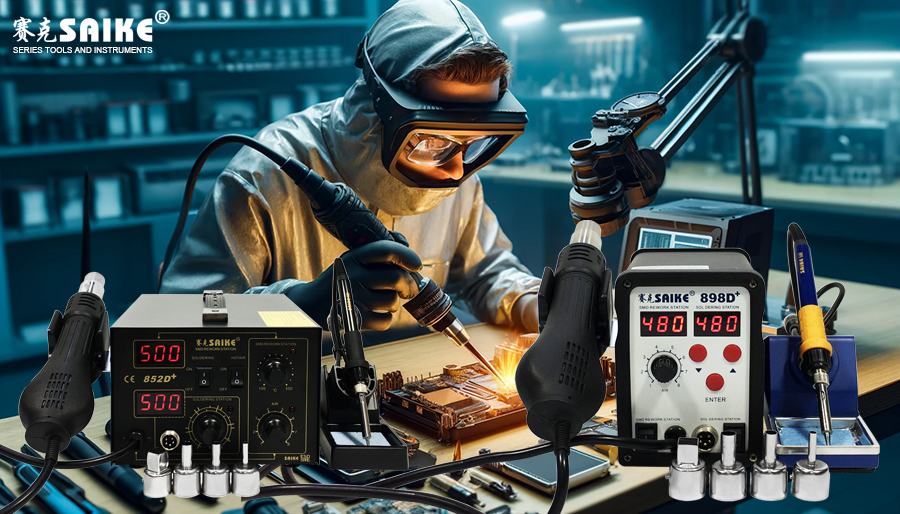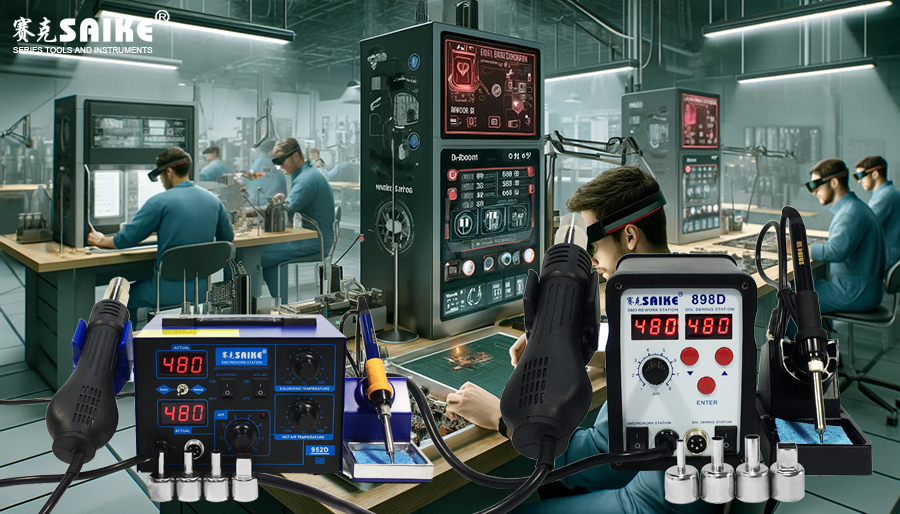
SK-YJ000RFCHT-KP 100028
In the modern electronic repair industry, desoldering high-density integrated circuits (ICs) often poses significant challenges, especially when dealing with precision devices such as smartphones, laptops, and other complex electronic equipment. The hot air rework station, as a precise heat treatment tool, plays a crucial role in this field. This article explores some advanced techniques to help technicians more effectively use hot air rework stations to handle high-density integrated circuits.
I. Characteristics and Challenges of High-Density ICs
High-density integrated circuits, specifically those with a large number of pins and extremely narrow pin spacing, such as Ball Grid Arrays (BGAs) and Quad Flat No-lead Packages (QFNs), present unique challenges:
1.Uneven heat distribution: Due to the tight arrangement of pins, uneven heat distribution can cause overheating in certain pins, potentially damaging the chip.
2.Need for precise temperature control: Both excessively high and low temperatures can harm the internal structure of the IC.
3.Avoidance of physical damage: It’s essential to prevent physical stress on the chip body and surrounding circuits during the desoldering process.
II. Application of Advanced Techniques
1.Precise Temperature Control
– Utilizing thermal imaging technology: Real-time monitoring of IC temperature using a thermal imager ensures uniform temperature distribution during the heating process.
– Programmed heating control: Setting the hot air rework station for programmed heating, such as preheating to a lower temperature and gradually increasing it, avoids thermal shock.
2.Optimized Airflow Management
– Employment of directional nozzles: Choosing specialized nozzles suitable for high-density ICs, such as those with a small diameter or specially shaped, allows for more focused and precise hot air direction.
– Adjusting airflow intensity: Modifying the airflow strength according to the specific needs of the IC prevents displacement of the IC or surrounding components due to excessive airflow.
3.Utilization of Low-Temperature Solder
– For highly sensitive high-density ICs, consider using low-temperature solder. This type of solder melts at lower temperatures, reducing thermal stress on the chip.
4.Implementing Local Shielding
– When applying hot air to the IC, use high-temperature tape or special protective films to cover adjacent sensitive components, preventing inadvertent heating.
5.Precise Desoldering Technique
– When desoldering packages like BGAs, specialized BGA desoldering equipment can be used. These devices, often used in conjunction with hot air rework stations, provide more accurate control.
III. Technical Operation Procedure
1.Preparation Phase
– Clean the IC and its surrounding area to ensure no dust or impurities are present.
– Check the settings of the hot air rework station, including temperature, airflow, and nozzle selection.
2.Heating Phase
– Initiate programmed heating, observe thermal imager data, and ensure uniform heating of all IC parts.
– Maintain the required temperature until the solder is completely melted.
3.Desoldering Phase
– Gently remove the IC using specialized tools like a vacuum suction pen, avoiding excessive force.
– Immediately clean and perform necessary repairs on the solder pads.
IV. Conclusion
Handling high-density integrated circuits with a hot air rework station requires advanced techniques and precise operations. By applying the aforementioned techniques, technicians can effectively manage these complex repair tasks, minimizing the risk of IC damage and enhancing the success rate of repairs. Continuous learning and practice of these advanced techniques will further elevate repair skills and service quality.


